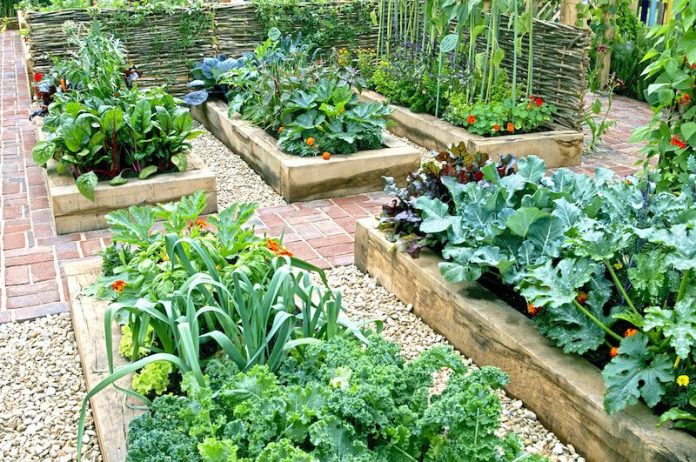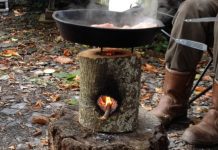Companion planting can not only help your growing plants thrive, they can also deter pests infestations that can greatly reduce your harvest yield. Grouping together specific plants may also help prevent the depletion of nutrients in the soil.
In fact, some common garden plants curtail the ability to thrive when either planted near each other or near specific trees and bushes that grow near your gardening areas. Keeping the border around your growing plots clear of debris and harmful trees, like the Black Walnut, will help prevent problems of yielding and eliminate places of harmful insects during the winter season or make their homes in the garden.
Benefits Of Companion Planting
Soil Enhancement
Using companion planting techniques to group together crops that can infuse additional nitrogen into the soil can improve your harvest.
Beneficial Insects
Not all bugs are bad. Courting beneficial bugs into your garden and providing them with a home in a cluster of companion plants might just improve your yield. Helpful insects aren’t eating your crop, but the bugs that dine on it.
Physical Support
Some plants, like pole beans, may grow steadily while supporting other crops-in this case, corn stalks. If plants are heavily loaded with vegetables, they will sink and cause breakage that will destroy the plant, allowing dangerous bugs and bacteria to enter.
Protective Herbs And Flowers
Planting a border of different herbs and marigold plants along the garden perimeter, and in with some companion plant groups, defending the most valuable crops against harmful insects and exposure to the wind.
Trap Crops
This form of companion planting uses both herbs and ornamental plants which urge harmful bugs in their direction only to sicken or kill them after being snacked upon. As a first line of protection against harmful insects, trap crops such as geraniums and borage should be planted either protective herbs and flowers at the border of the garden or just several feet in front of the protective border. Both geraniums and borage should be planted near crops that Japanese beetles love – such as broccoli and cabbage. The plant scent will attract the highly destructive beetles in their path and then kill them after they have been chewed on.
In your companion plant model, nasturtiums are also great trap crops to layout. They’ll be drawn to beetles of almost all forms and aphids. When the nasturtiums have been packed with the dangerous insects, remove them carefully from the ground and drown or burn the insects.
Related: Protecting Your Garden Against Pests And Diseases
Shelter
When plants are prone to either sunlight or wind, or both, are overexposed to extremes of this kind of weather, they can die within days. According to companion planting protocols, less fragile plants in a grouping may protect others, without harming their own growing path.
Walnut Tree Dangers
None of those trees should be near your garden. A single black walnut tree grown within 100 feet of growing space will destroy all your diligent companion planting efforts.
These release juglone, a chemical compound, into the ground. Juglone causes leaves to wilt and yellow – and even the untimely death of otherwise healthy plants. The chemical compound in black walnut trees is not only present on branches and leaves, but also in the nuts which lay on the ground. Juglone is also secreted through the root system of the black walnut tree.
How much juglone the black walnut trees excrete will vary according to season. The amount of juglone present in the tree is reaching its peak as the nut starts to mature. This takes at least two months after cutting the fruit, to extract the chemical from the soil.
Both walnut trees breeds make juglone, including hickory, pecan, and butternut trees, but the black walnut has the highest percentage of this crop killer. Plants that are most susceptible to juglone include tomatoes, varieties of pepper, Aubergines, and potatoes. Onions, corns, beets, and carrots tolerate the chemical compound than others.
Walnut tree leaves can be safely composted but not until two weeks after falling to the ground or staying on a cut branch. It takes at least 14 days to detoxify for air, water, and environmental bacteria once it is removed from the tree.
Related: 10 Trees Every Survivalist Should Know and Why
Asparagus, Cabbage, Peppers, Tomatoes, Rhubarb, Eggplant, Alfalfa, Narcissus, Potatoes, Jack in the Pulpit, Columbine, Crab Apple Trees, Chrysanthemum – select varieties, Phlox, Nectarine Trees, Cherry Trees, Bugleweed, Lilies, Hydrangea, Spiderwort, White Birch Trees, Bellflowers, Ginger, Lilac Bushes, Plum Trees, Peach Trees, Lamb’s Ears, Hollyhocks, Rhododendrons, Hostas, Geraniums, Crocus, Wood Ferns should never be cultivated near juglone producing trees.
Garden Companion Plant Guide
| Companion Plant | How To Group Or Use It |
|---|---|
| Basil | • Repels mosquitoes • Improves flavor and growth of tomatoes • Never plant near rue. |
| Bush Beans | • Plant with corn, cauliflower, potatoes, cabbage, carrots, beets, cucumbers, summer savory, potatoes, strawberries, catnip, marigolds • Never plant with garlic, onions, shallots, or fennel. • Green beans help curtail potato beetles. |
| Pole Beans | • Plant with radishes and corn. • Never plant with bets, garlic, potatoes, kohlrabi, marigold, leeks, or shallots. |
| Beets | • Plant with onions, bush beans, cauliflower, broccoli, cabbage, chard, kohlrabi, and Brussels sprouts. • Never plant near charlock, mustard, or pole beans. |
| Borage | • Plant with squash, tomatoes, and strawberries. • Borage curtails tomato worms. |
| Brussels Sprouts and Broccoli | • Plant near thyme, carrots, beets, dill buckwheat, onions, chamomile, calendula, sage marigolds, hyssop, rosemary, nasturtiums, and wormwood. • Never plant with strawberries. |
| Cauliflower and Cabbage | • Plant with chard, broccoli, celery, brussels sprouts, tomatoes, and spinach. • Never plant near strawberries. |
| Cantaloupe | • Plant near corn |
| Carrots | • Plant near chives, leeks, sage, cabbage, rosemary, peas, early potatoes, radishes, lettuce, wormwood, and salsify. • Leeks, wormwood, and onions can deter carrot flies. |
| Chives | • Plant near grapes, peas, apples, tomatoes, berries, roses, and carrots. • Chives deter aphids and Japanese beetles and help their companion crops thrive. |
| Corn | • Plant near early potatoes, melons, squash, pumpkins, green beans, cucumbers, and peas. • Soybeans will help prevent chinch bugs. |
| Cucumbers | • Plant with radishes, early potatoes, corn, sunflowers, green beans, cabbage. • Never plant with late potatoes. • Radishes will ward of various types of beetles that attack cucumbers. |
| Dill | • Plant with onions, broccoli, lettuce cucumbers, Brussels sprouts, and cabbage. • Never plant near carrots. • Dill will bolster the growth of cabbage plants and may improve flavor. |
| Eggplant | • Plant near potatoes, tomatoes, peppers, and green beans. |
| Garlic | • Plant near fruit trees, cane fruits, cabbage, tomatoes, and roses. • Never plant with peas or green beans. • Garlic will deter Japanese beetle and aphids. They also help prevent blight in late potatoes. |
| Kale | • Plant near buckwheat, marigolds, cabbage, nasturtiums, and aromatic herbs. • Never plant with pole beans or strawberries. |
| Lettuce | • Plant with strawberries, beets, carrots, radishes, and parsnips. • Never plant with cabbage. |
| Mustard | • Plant amid fruit trees, legumes, alfalfa cover crops, and grapes. |
| Onions | • Plant with carrots, beets, chamomile, cabbage, parsnips, and lettuce. • Never plant with green beans or peas. • Onions deter maggots and a myriad a of potentially harmful insects. |
| Oregano | • Plant as a garden border to repel destructive insects. Oregano is safe to plant near any standard garden crop or fruit producing tree or bush. |
| Parsley | • Plant with tomatoes, corn, and roses. |
| Parsnips | • Plant near onions, wormwood, and radishes. • Onion and wormwood plants will deter root maggots from feasting upon the parsnip crop. |
| Peas | • Plant near corn, carrots, early potatoes, green beans, turnips, cucumbers, and radishes. • Never plant with onions, shallots, garlic, or leeks. |
| Peppers | • Plant next to carrots, onions, tomatoes, basil, eggplant, parsley, and eggplant. • Never plant near fennel or kohlrabi. |
| Potatoes | • Plant near cabbage, flax, peas, hemp, marigoldsm, squash, basil, eggplant, green and other bean varieties. • Never plant near apple trees, walnut trees, raspberry bushes, cucumbers, pumpkins, birch trees, cherry trees, tomatoes, or sunflowers. • Basil will ward off potatoes beetles. |
| Radishes | • Plant near peas, lettuce, chervil, peas, melons, cucumbers, nasturtiums, and root crops. • Never pant near hyssop. |
| Rosemary | • Plant next to any type of bean crop, carrots, and cabbage. • Rosemary can help thwart carrot flies, cabbage moths, and bean beetles. |
| Sage | • Plant sage next to carrots, cabbage, and tomatoes. • Never plant sage near cucumbers. • Sage can thwart carrot flies, cabbage moths, and help the tomatoes grow. |
| Soybeans | • Plant next to corn and potatoes. • Soybeans can kill weeds and enrich the nutrient content of the soil. |
| Spinach | • Plant with or near cauliflower, eggplant, celery, and strawberries |
| Strawberries | • Plant near borage, spinach, pyrethrum, bush beans, and lettuce. |
| Sunflowers | • Plant sunflowers with or near cucumbers. • Never plant with any type of potato variety. • Sunflowers offer shade for plants and can serve as a trellis for growing plants. |
| Swiss Chard | • Plant with kohlrabi, onions, and bush beans. • Never plant with pole beans. |
| Tarragon | • Plants near or in with any standard garden vegetables. • Tarragon can bolster plant growth and enhance flavor of companion plants. |
| Thyme | • Plant near any standard garden vegetables. • Thyme deters cabbage moths. |
| Tomatoes | • Plant next to onions, basil, carrots, asparagus, mustard, cabbage, mustard, rosemary, stinging nettles, gooseberries, sage, and parsley. • Never plant with walnut trees, fennel, kohlrabi, or early potatoes. |
| Rutabagas and Turnips | • Plant near or with peas. • Never plant with knotweed or mustard. Either vegetable will diminish the growth of these plants. |
After walking around your garden area to clear it from walnut trees or debris bugs, sketch your rows or container alignment with the border areas first followed by companion plant groupings to help give your crops the best start to life – and a bountiful harvest for your family.





















